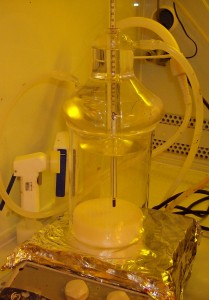Process Name:
KOH01.
Note: In the ANF, we also use TMAH 25%, as well as Transene Silicon-etch solutions. The procedure is similar except that the solutions are already prepared.
Author:
Mark Bachman, Fall 1999. Adapted for AMPEL ANF by M. Beaudoin, April 2014.
Overview:
KOH is a wet etch which attacks silicon preferentially in the <100> plane, producing a characteristic anisotropic V-etch, with sidewalls that form a 54.7° angle with the surface (35.3° from the normal). This etch process is independent of the doping concentration for As, P and Sb. For B, the <110> etch rate drops quickly at high doping concentrations. This is a dangerous (ie strong base) process and requires the dangerous wetbench processes qualification. The use of dangerous chemicals requires that the user may not perform the process alone.
Time Needed:
The KOH process takes typically 1 hour for a 40 μm etch: 20 minute prep time followed by 40 minutes etch. Lithography and reactive ion etch take additional time. TMAH and the various Silicon etch solutions have different etch rates.
Materials Needed:
- 100 silicon wafers with thermally grown oxide or nitride layer (~2000–3000 Å)
- KOH pellets (available from chem stores)
- Glass container
- Thermometer
- Stirrer Hot plate
- The condenser top beaker assembly located in the wetbench (pictured)
Preparation:
Wear protective acid (orange) gloves, the apron and eye protection including full face shield. Prepare a fresh KOH solution in the following manner. Weigh 1 part KOH pellets (by weight) into a plastic beaker. Add 2 parts DI water. For example, use 100 g KOH with 200 ml water. Mix on warm surface until KOH has dissolved. Add 40 ml of isopropyl alcohol to the solution. The isopropyl alcohol increases the anisotropy in the etch. Store in plastic bottle labeled “30% KOH solution”, then add your name, the date, and a target organs sticker.
KOH recipe (30%)
- 70 g KOH pellets
- 190 ml DI water
- Mix on warm surface until KOH has completely dissolved.
- Add 40 ml isopropyl alcohol
The KOH etch requires a “hard mask” of silicon dioxide or silicon nitride (nitride is preferred since oxide is slowly etched by KOH). The details on making a hard mask can be found in other documents. The basic approach is as follows. Start with silicon 1-0-0 polished wafers. Clean wafers and pattern with photoresist. Use the reactive ion etch (RIE/PECVD) system to etch the exposed oxide or nitride surface. For oxides, the recommended chemistry is CF4 and O2. Etch until the silicon is exposed (shiny); typically 5 minutes per 100 nm film. Rinse the wafer with acetone to remove the remaining photoresist. Rinse with isopropanol. Rinse with DI water, then blow dry.
Procedure:
Put KOH solution in glass container and warm to 80° C on a hot plate. If desired, use the stirring mode to agitate the solution. Place patterned wafer (with patterned hard mask) in the KOH solution. The KOH will bubble at the exposed silicon sites while etching occurs. The etch rate for 30% KOH at 80°C should be about 1 micron/minute.
Cleanup:
Dispose etchant in ANF labeled waste container. If none exist, create one using a cleaned used plastic solvent bottle and label it with the name of the chemical, your name, the date and the indication that it is a strong base. Also clearly label it as waste. KOH (and other) anisotropic etch solutions can be used several times before disposal. Rinse all labware three times with DI water. In very small amounts (less than 30 ml): Dilute the KOH with cold water, then pour the solution down the sink, flushing with plenty of DI water.
Safety & Emergency:
All ANF safety and procedural regulations must be followed. Use of KOH requires at least one other person in the clean room (buddy system). KOH should be handled in a laminar flow bench, using apron, acid (orange) gloves and eye protection including full face shield. Any small spills should be wiped up immediately with wipes. Rinse the wipes in the sink with DI water and dispose of in the waste container. DO NOT LEAVE the etchant on the hot plate unattended.
In case of exposure to skin or eyes, flush immediately with water for 30 minutes. Remove all clothing that are exposed and flush with water. Report to ANF staff or report to UBC Risk Management. Seek medical attention to ensure that the burns are minimal. In case of large spill, follow the ANF Standard Operating Procedure for chemical spills.
References:
- W. Kern and J. Vossen, Thin Film Processes, Academic Press: New York, 1978, Ch V-1.
- L. Ristic, Sensor Technology and Devices, Artech House: Boston, 1994, Ch 3.
Checklist:
The following checklist is designed to aid the researcher when performing this process.
- Substrate must be clean with hard nitride or oxide mask. No photoresist.
- Prepare KOH solution: 30% KOH by weight (or use one of the other solutions).
- Heat to 80 °C on hot plate. Stirrer may also be used.
- Soak wafer in etchant. Don’t cover.
- Etch rate is about 1 micron/minute.
- Remove early, DI rinse / blow dry. Check on profilometer.
- Clean up, dispose wastes.
